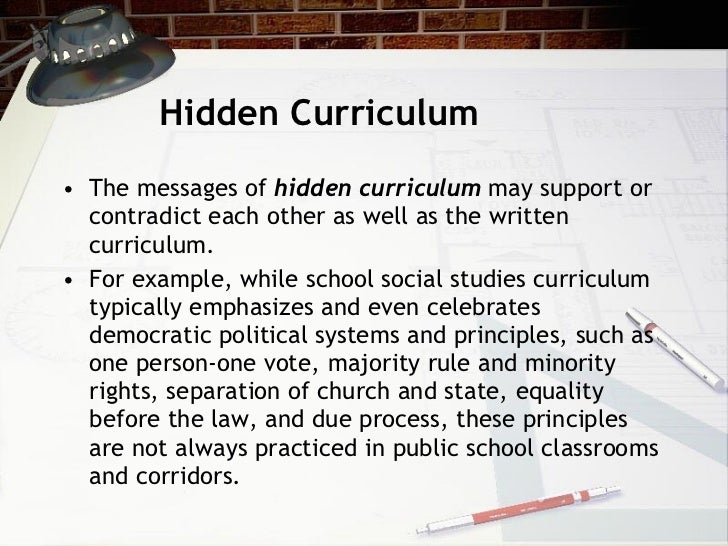Imagine a classroom filled with students, all diligently absorbing the information laid out before them. But what if the most profound lessons aren’t found in the pages of textbooks or the words of teachers? What if the true learning takes place in the subtle interactions, the unspoken norms, and the everyday practices that shape the very fabric of the educational experience? This, my friends, is the realm of the hidden curriculum, a powerful force that can mold our values, beliefs, and behaviors in ways we might not even realize.

Image: helpfulprofessor.com
The hidden curriculum refers to the informal, often unacknowledged, and sometimes unintentional lessons that students learn in school. It encompasses the unspoken rules, expectations, and social dynamics that permeate the educational environment. While formal lessons might focus on academic subjects like math and history, the hidden curriculum teaches us about social skills, cultural norms, and our place in the world. This isn’t just a theoretical concept; it’s a lived experience that shapes the trajectory of our lives.
Unveiling the Hidden Curriculum: Examples in Action
The hidden curriculum manifests itself in countless ways, subtly shaping our understanding of the world. Let’s delve into some real-world examples:
1. The Power of Silence and Obedience:
Imagine a classroom where students are expected to sit quietly and passively receive information, raising their hands only when explicitly permitted. This unspoken rule, often referred to as “teacher-centered instruction,” might teach students to value obedience and conformity over independent thinking and questioning. The message subtly conveyed is that knowledge is something to be received rather than constructed.
2. The Gendered Divide: A Silent Social Script
Ever noticed how certain toys are designated for boys and girls? In the classroom, this gendered divide might manifest in subtle yet pervasive ways. Boys might be encouraged to engage in competitive activities, while girls are steered towards nurturing roles. The hidden curriculum can perpetuate stereotypes by reinforcing traditional gender roles, limiting opportunities, and potentially impacting career choices.

Image: immigrant.com.tw
3. Race and the Curriculum: A Hidden History
The hidden curriculum often reflects the dominant cultural narrative, inadvertently silencing marginalized voices. For instance, a history curriculum that focuses exclusively on the perspectives of the majority group leaves out the stories and contributions of other cultures, creating a distorted view of history and reinforcing a sense of power imbalances.
4. The Value of Competition: The Race to the Top
From standardized testing to classroom rewards, many schools focus on comparative achievement, fostering a competitive environment. This might teach students that success is a zero-sum game, where one person’s victory comes at the expense of another’s. While competition can serve a purpose, its unbridled emphasis can create a culture of anxiety and discourage collaboration.
5. The “Ideal” Student: A Portrait of Conformity
Schools often have unspoken rules about what constitutes a “good student.” This might include being quiet, conforming to expectations, and achieving high grades. However, these criteria may not encompass diverse learning styles, creative thinking, or emotional intelligence. The hidden curriculum can inadvertently disadvantage students who don’t fit the mold, reinforcing the pressure to conform and stifle individual expression.
Beyond the Classroom: Navigating the Hidden Curriculum in Everyday Life
The impact of the hidden curriculum extends far beyond the confines of the classroom. It shapes our interactions with colleagues, our social expectations, and our understanding of the world.
1. Recognizing Patterns: The Unconscious Bias
Once we are aware of the hidden curriculum, we can begin to recognize its pervasive influence in our lives. This critical awareness allows us to question the unspoken rules and expectations that shape our thoughts and actions. It empowers us to challenge stereotypes, promote inclusive environments, and foster a more equitable society.
2. Challenging the Status Quo: Becoming Agents of Change
By understanding the hidden curriculum, we can actively challenge its negative implications. We can advocate for more inclusive and equitable classrooms, promote critical thinking and diverse perspectives, and encourage students to develop their unique talents and strengths.
3. Building a More Equitable Future: Unmasking the Hidden Curriculum
The hidden curriculum is a powerful force, but it’s not insurmountable. By becoming aware of its influence, challenging its detrimental aspects, and promoting a more inclusive and equitable environment, we can help create a world where everyone has the opportunity to thrive.
The Hidden Curriculum Examples
Conclusion: Unmasking the Hidden Curriculum
The hidden curriculum is a complex and multifaceted aspect of education. It’s vital to understand its influence and to work towards creating a more just and equitable educational system that values diversity, critical thinking, and compassion. By embracing the hidden curriculum and challenging its shortcomings, we can build a more inclusive and fulfilling future for ourselves and generations to come. Let us all strive to be agents of change, consciously shaping the hidden curriculum for a brighter and more equitable tomorrow.






